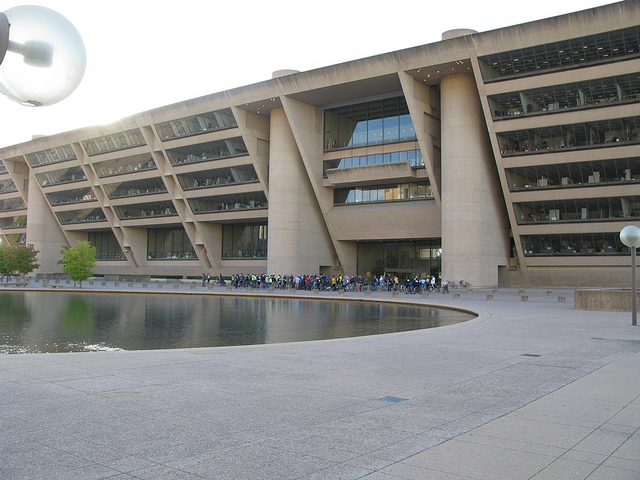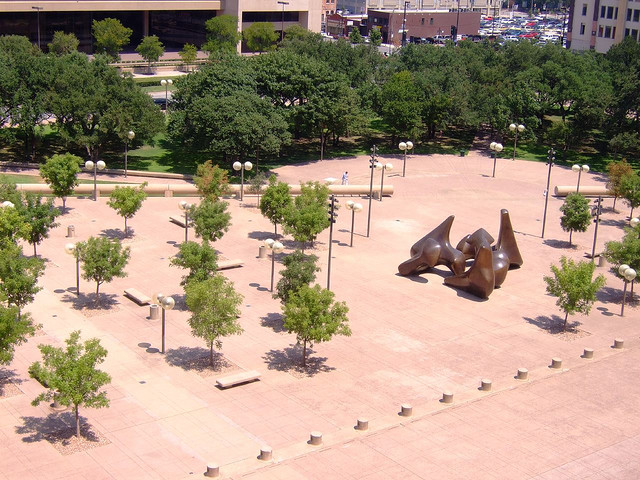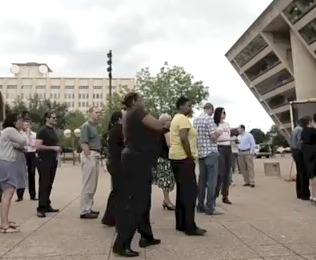Cross-posted from the Natural Resources Defense Council.
Although it sometimes makes “ugliest building in the world” lists, I rather like I.M. Pei’s iconic Dallas City Hall, featuring his trademark architectural triangles.
 Photo: Chris Zúniga
Photo: Chris Zúniga
But I’ll grant that it is imposing. What I don’t like is the vast, forlorn “plaza” and pool that separates the city’s most important civic building from its citizenry and from the street. By all accounts, it’s six acres of dead space, except perhaps when various protests need a place to gather. “A concrete desert,” wrote Ryan Jones on the FrontBurner blog, hosted by DMagazine. “Almost always, without fail, empty.” In fact, looking at the satellite image, one can see that the plaza and city hall are also surrounded by vast surface parking lots. Isolation and vastness compounded by more isolation and vastness.
 Photo: Jen R
Photo: Jen R
For at least one day last month, all that changed. The pop-up urbanists who bring us the very cool Better Block projects, which also originated in Dallas, partnered with the CityDesign Studio of Dallas, the Trinity Trust, and other partners and supporters, to create “Living Plaza,” a project to show what the City Hall Plaza could be like with a little more energy and imagination. For about $1,500 plus volunteer labor, the project brought chairs, tables, games, music, and food to the space — you know, like some cities have all the time.
Better Block leader Jason Roberts described the event on the organization’s website:
Team Better Block, alongside the bcWorkshop, CityDesignStudio, Trinity Trust, Downtown Dallas Inc., Modern Relics, and others helped transform Dallas City Hall’s barren and lifeless plaza into an active, livable environment. The groups brought out a storage container converted into a food commissary where Jaime’s Tamales, Oak Cliff Crepe Company, and Brady’s BBQ set up shop to provide food for all who came onsite. An assortment of tables and chairs were also spread out alongside plants, trees, checkerboards, giant chess sets, and more. Our recycled pallet wood benches and trellises also helped frame the stage as city employees, council members, and area business people all came out to enjoy the day.
It was a hit. “I feel like I’m in Austin right now,” downtown worker Kalye Johnson told a local TV station. “I really like the air and everything about it. I think it’s cool — very different.”
A plan to bring more people to the plaza was actually proposed nearly 30 years ago by legendary urban thinker and observer William H. “Holly” Whyte. The findings in Whyte’s report to the city council [PDF] are as true today as they were in 1983:
Right now some 1,500 people are working right next door to the plaza, yet few use it. Something, patently, is wrong and needs to be set right …
There was remarkable concurrence on the main points: more events, more trees and grass and greenery, more places to sit, something to sit under, food and tables and chairs …
There should be much more seating on the plaza; it should be more comfortable; and it should be sited in relation to sun and shade and to the configurations people find most congenial.
Put out movable chairs …
More events should be scheduled …
Do more with the pool. It is a fine feature and artfully designed to be safe for wading. So why not have wading? And splashing about …
On an April Wednesday, during workers’ lunch hour, the appeal of Whyte’s vision was demonstrated.
Well, maybe not the splashing about. Part of the plan was to have kids’ toy boats floating in the pool, something like the little sailboats in Paris’s wonderful Jardin du Luxembourg. There was a problem with the boat supplier. But there was another problem anyway, according to Roy Appleton, writing for the Dallas Morning News:
But then there was the plan for floating small boats yesterday in the plaza pool. OK, the group that was supposed to supply the craft backed out. But if they had been there, the city permit office told organizers they couldn’t put no stinking boats in the pool because by golly such behavior hadn’t been stipulated in the event application. Ah, some things never change.
That noted, there may be some good news from Dallas’s officialdom. After the Living Plaza event, some city council members said City Hall Plaza could be a future expansion location for mobile food vendors, according to a post by Ken Kalthoff on the NBC Dallas-Fort Worth website. Apparently the council has already approved a measure to allow food trucks in the city’s Arts District.
Here’s some local TV coverage of the event:
There’s also a nice video of the Living Plaza event produced by the Dallas publication the Advocate:




